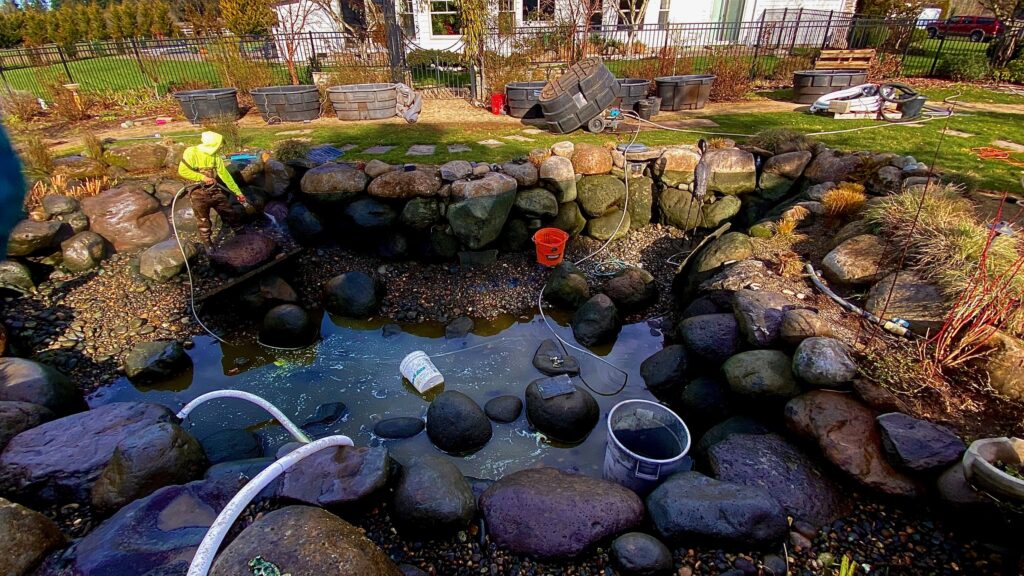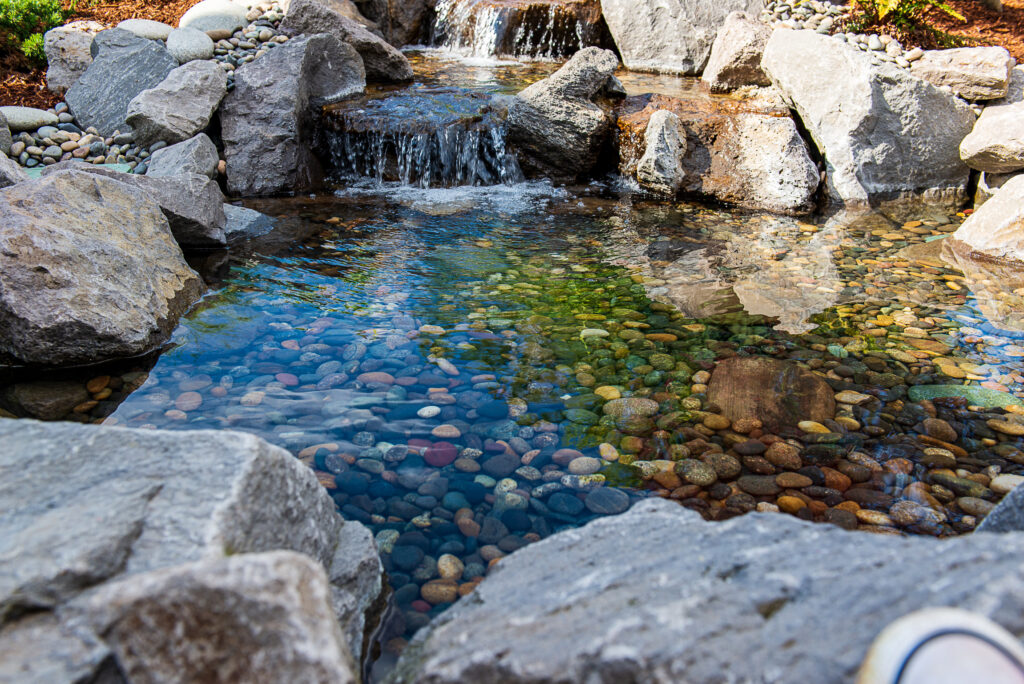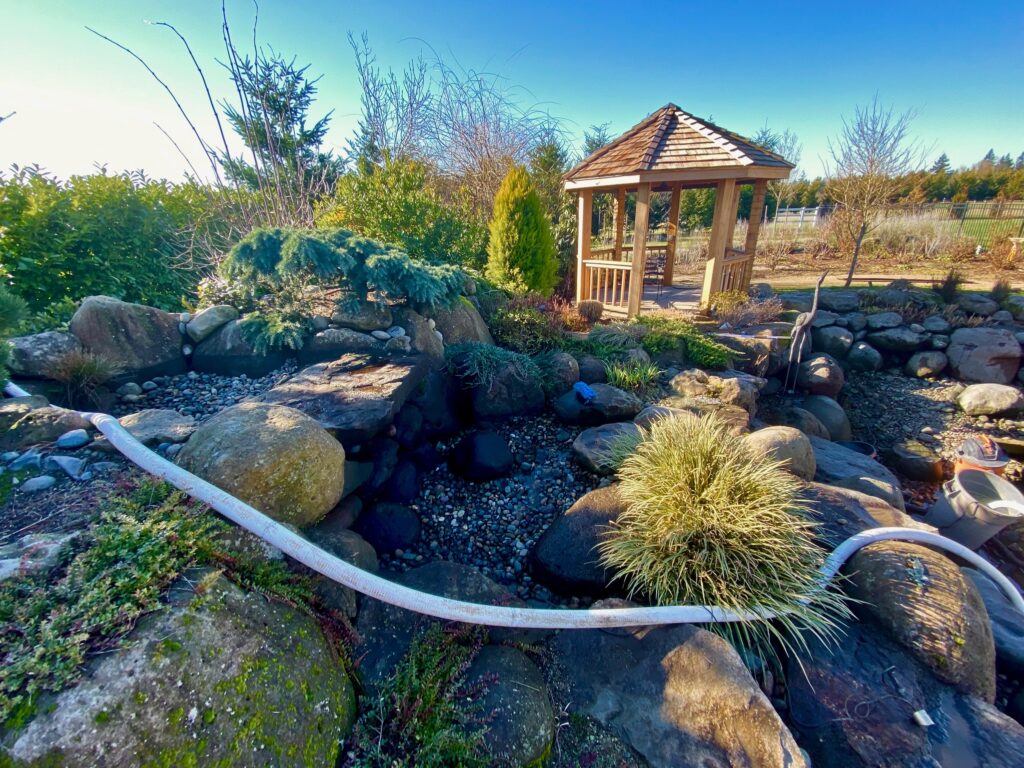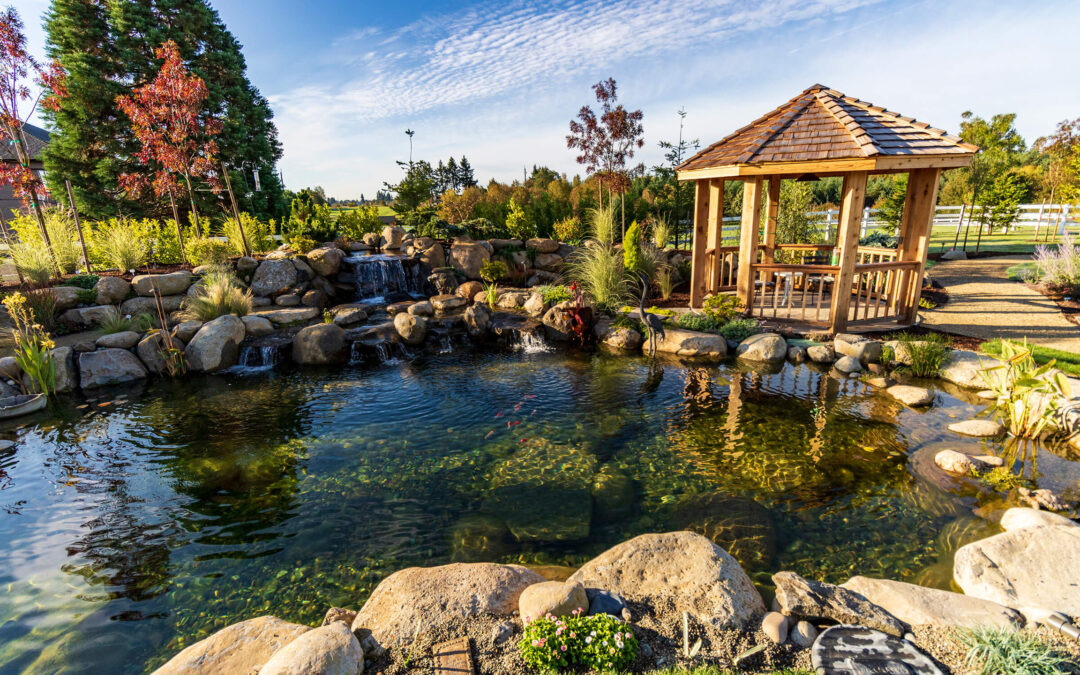Having a koi pond or water feature is an amazing way to unwind and relax. Koi ponds and other natural outdoor spaces create a space for you to mentally cleanse from the day. But it is hard to sit by one if it is overrun with algae and smells. And if you have koi fish in your water feature, then you could be killing them. Cleaning your pond does not have to be an arduous task – Greenhaven can do it for you! Read on and we will give you the benefits of a professional cleaning and tips on how to maintain your fish pond for happy and thriving fish.
What is the best time of year to clean out a pond?
The best time to clean a pond is during the spring or fall when water temperatures are warmer and debris, like leaves, has accumulated which gives you the most bang for the effort. This also prepares your garden pond for the next season. However, you are the best decider of when to have your koi pond cleaned. If you are just not enjoying your pond or see that your fish are stressed it is time to prioritize a cleaning.

Spring Koi Pond Cleanup
As the water heats up into summer, bad bacteria, diseases, and parasites grow and can become an issue in the hotter months. Removing these will keep your pond fish and plants happier. It also helps you get ahead of algae blooms that make a pond unsightly.
Fall Koi Pond Cleanup
Muck and decomposing debris release ammonia and other chemicals into your koi pond which can stress fish and plants. Cleaning out muck and debris from the bottom of your pond before winter sets in keeps it from being trapped under winter ice and helps your fish stay healthy.

How often should a pond be cleaned?
It is recommended that pond owners deep clean their decorative pond or water feature at least once a year. If you have a lot of leaf debris from a nearby tree you may want to clean your pond more frequently. The frequency of koi pond cleanings will also depend on the size and depth of your pond and how many fish you have. To keep your pond free year-round from pond scum you can have a pond maintenance company come out regularly to keep it clean.
Why is my pond water green or brown?
Green or brown pond water is usually caused by an excess of algae growth in the pond, which can happen when there are imbalances. Algae feed on pond nutrients such as nitrates and phosphates, creating cloudy green or brown pond water.
What causes pond algae growth?
Algae growth can be caused by a variety of factors including feeding your fish too much or even too many fish in your pond. Too many fish creates a lot of fish waste which leads to imbalanced pond water chemistry. Pond algae overgrowth can also be a sign that your pond filter needs to be cleaned or that your water contains an excess of nitrogen and phosphorous.
Types of pond algae
If your water feature is beginning to accumulate an abundance of unsightly algae, you are certainly not alone. Hundreds of varieties exist and can have a devastating effect on the oxygen levels in your water, affecting your fish and pond health.
String algae
String algae is a type of pond algae that grows in long, stringy strands and quickly takes over your pond if left unchecked. The best way to get rid of string algae is by vacuuming the pond bottom, cleaning the pond liner, and skimming the pond surface on a regular basis to remove as much excess organic material as possible.
Blanket weed algae
Also known as pond moss, blanket weed is a common type of algae that looks like clumps or mats of green or brown ‘fur’ on the surface of the pond. The best way to get rid of blanket weed is by using treatments that target blanket weed algae specifically.
Green algae
Green pond algae can quickly turn your garden pond, well, green, and make it difficult to see the fish. Regular cleanings are one of the best ways to reduce this type of pond algae, as well as using treatments or chemicals that specifically target green pond algae.

New Pond Set Up
If you just had a new backyard pond installed it is important to talk with your landscaper about how to encourage beneficial bacteria and maintain it. Often homeowners don’t have time to to maintain their pond. Just ask if they provide pond maintenance which will free you up to simply enjoy your yard. If you are looking for ideas on how to design a pond for your yard you can look through our gallery.
How pond plants can help your pond
To drastically improve the appearance of your pond and limit algae growth, we highly suggest including floating plants. Not only are they aesthetically pleasing but also restrict further development of any existing algae.
Also, many water plant species act as natural air purifiers that supply additional oxygen to your water while consuming essential nutrients required by aquatic vegetation like algae. For optimal results, it’s best to chat with a knowledgeable expert about the best kinds of flora for you to add to your water feature.
Preventing Algae
Algae thrive on three things: nutrients, sunlight, and warm water. The best way to avoid unsightly and problematic algae in your pond is to restrict these from getting into your water. Nutrients can come from runoff fertilizers, fish, debris, and other things that get into your pond. Warm water comes from too shallow a pond depth which is heated up by sunlight.
Well-placed plants along the edge can provide shade and stop nutrients from getting into your pond. Make sure that you consider how to maintain your pond when discussing design with your landscaper.
Ways to Keep Your Pond Clean
Keeping your pond clean requires creating a schedule. There are plenty of pond treatments available to help keep pond algae under control and make pond cleaning easier. Here are some tips for keeping your pond clean.
Invest in a pond rake
This will help you remove large debris like leaves, muck, algae, and other debris that can cause garden pond water to become murky. Just 10 minutes a week can make a difference in reducing cloudy pond water. If you have a larger pond it might be helpful to remove debris daily to keep the cleaning from being overwhelming.
Use a net
Regularly skim the surface of the pond to remove any debris such as leaves, twigs, and pond insects. This can help keep the pond looking tidy and is important for pond aeration.
Use pond treatments
Pond treatments like algaecides can help manage algae growth in your pond by reducing the amount of nutrients available to feed organisms that cause pond water to become cloudy and murky.
Change your filter
Make sure to change your filter regularly. The filter should be replaced twice a year in the spring and autumn.
Add pond plants
Introducing plants to your koi pond is always a smart choice. Not only do they serve as natural temperature moderators, but also offer vital protection from the sun’s rays for fish and other aquatic creatures.
Pond dye
You can also add pond dye to your pond to reduce the amount of sunlight that reaches pond algae. Food-grade dyes and veterinarian-approved dyes are used to create pond dyes or colorants.
Colorants not only make pond water appear more vibrant, but they can also help to reduce water temperature. When a pond’s waters heat up, the oxygen levels drop and this has damaging effects on fish – as well as promoting an algae bloom. Furthermore, darker water provides an effective barrier against predators making it harder for them to see your fish.
Barley straw
If you’re experiencing an algae issue in your pond, try floating a mesh bag of barley straw on the water’s surface – approximately 50g per sq m (1½ oz. per sq yd). Introduce this solution in the spring and remove it when it has turned black (usually six months later). Infusing lavender into the barley straw has also been found to increase effectiveness.
What are beneficial bacteria?
Beneficial bacteria are microscopic organisms that break down debris and leftover nutrients into non-toxic gas. When your algae lack sufficient amounts of food for growth, it will eventually die back.
These helpful microorganisms make their homes on surfaces like filter pads – which is why you should avoid cleaning them too frequently or thoroughly. If water flow becomes obstructed a light rinse with pond water should work to get it flowing again and keep the good bacteria in your system.

Steps to Cleaning a Pond
Water features and ponds are a beautiful addition to any backyard, small or large, but there is some maintenance that is needed to keep them looking their best. Most cleanings are easy with a deep cleaning about once a year. It is important to know the different steps needed to improve water quality for your koi pond or water feature.
Remove the koi fish
If you are doing a deep koi pond cleaning, all the fish should be safely removed and placed in an oxygenated holding tank or large container. This step is only needed if you are going to drain the pond entirely for a deep cleaning. If you don’t have a koi pond, skip this step and move on to the next one.
Clear debris from the surface
During pond cleaning, it’s important to remove any excess surface debris that will just end up as more sludge at the bottom of the pond you will have to remove. You may also want to use a pond vacuum to get rid of any algae growth or other organic waste that may be present in the pond.
Drain the pond
If your pond has become overgrown with algae and has a lot of sludge-y debris then you will probably need to completely drain your pond. The water can be drained using a submersible pump or by using a hose to siphon the pond water out. If you have any pond plants or fish, you’ll want to remove them carefully before draining the water. Once the pond is empty, it’s time to tackle that stubborn dirt build-up and grime that has accumulated on your pond liner.
Clean pond liner
Now that your pond is drained, it’s time to tackle that sludge at the bottom and sides. Too much of this can be detrimental for fish, but don’t fret! There is no need to equip yourself with rubber gloves and a brush. Instead, opt for a convenient pond vacuum cleaner which requires minimal effort compared to manual labor.
Clean out any filters and pumps
Next, tackle the filters and pumps. Make sure to clean these items thoroughly, as they are essential for keeping your pond’s water clean. Use a little pond water to keep good bacteria in the filter. A brush or other pond-cleaning tool is helpful to remove any dirt or debris from the pumps and filters.
Putting it back together
Once everything has been cleaned it is time to put your pond back together. Add water, put the plants back, test the water for the proper pH, and acclimatize your fish to the new water environment. This involves introducing pond water and equalizing the water temperature of their holding tank water to the water in the pond.
Tips for Regular Pond Maintenance
Regular cleaning helps keep your pond in tip-top shape and ensures that your plants and fish stay healthy and happy. By taking the time to regularly check your pond’s water levels, test its water quality, and perform regular pond cleanings you can be sure that your pond is in good condition for years to come!
Test pond water quality
Checking fish pond water quality is also important to ensure that the pond’s environment is healthy. Test the pond’s pH levels, ammonia, and nitrates to make sure they are all within acceptable ranges for your pond inhabitants.
Check water levels
Keeping a regular check on the water levels of your pond is important because it can help to prevent problems like algae blooms or fish deaths. Make sure to check that the water level stays consistent and if not, add additional water as needed.
Rake out algae and debris
Regularly remove any weeds, leaves, or other debris from the water to prevent problems.
Clean filters
Clean fish pond filters on a regular basis, clearing clogged filters to prevent potential problems like algae blooms.
Maintain plants
Regularly trim back any overgrown or dead foliage from water plants in order to ensure they stay healthy.
What are the benefits of professional pond cleaning?
A professional cleaning can help remove any built-up sludge, debris, and algae from your pond. It can also help rid your pond of any mold, mildew, and bacteria that may have been present. In addition, pond cleaning will help keep the pond’s pH balanced and prevent the growth of unwanted pond dwellers such as mosquitoes and other insects. A professional pond cleaning will also ensure that your prized koi stay healthy during the transfer and are returned safely to their home.
Overall, regular pond cleanings are essential to keep your pond healthy and free from bacteria, mold, and algae. A koi pond cleaning can help ensure that your pond is a safe and enjoyable environment for both plants and fish to thrive in.
What’s included in pond cleaning?
Pond cleaning includes removing debris and sediment from the pond, such as leaves, sticks, and other organic matter. It also includes removing any excess algae or pond plants that may be overcrowding the pond. A pond specialist can also help with water testing to determine any possible pond imbalances that might need to be addressed.
Regular pond maintenance keeps pond water clear and free of debris, dead leaves, and algae ensuring your pond plants and fish are healthy and safe from any potential harm caused by an excess of pond nutrients or algae.
Quick Tips on Maintaining a Pond’s Ecosystem
Cleaning a pond helps to keep the delicate pond ecosystem balanced. Once your pond’s ecosystem is back in balance there are things you can do to keep it that way.
- Regularly check pond water for signs of pond imbalances such as pH, ammonia, and nitrate levels. Testing pond water helps to determine any possible pond imbalances that might need to be addressed.
- Run a pond filter system continuously—this helps to keep the pond clean by removing small particles of debris from the pond water.
- Regularly check pond plants for signs of disease or pests and treat them accordingly. Plants are a natural filter in the pond ecosystem, so it’s important to keep them healthy and happy!
- Add beneficial bacteria and keep them healthy
- Remove any pond debris like leaves, sticks, or algae regularly as these can lead to pond imbalances.
- If you have a fish pond, make sure to feed your fish a healthy diet (but don’t overfeed!) and check for signs of disease or parasites.
Regular pond cleaning is important for the health and well-being of your pond’s plant and animal inhabitants. Keeping on top of maintenance will help keep your pond looking its best.
Professional Pond Cleaning in Vancouver, Wa
Water is so important to those of us who live in the Pacific Northwest. Having a pond or water feature in our backyard is just a little slice of peace and mental wellness. For over 25 years, Greenhaven has been building and maintaining ponds in the Vancouver and Portland area. Our pond maintenance team are experts in fish care and keeping your water feature looking its best year after year. Enjoy a beautiful, healthy pond without the hassle. Contact Greenhaven today for pond maintenance quote.

